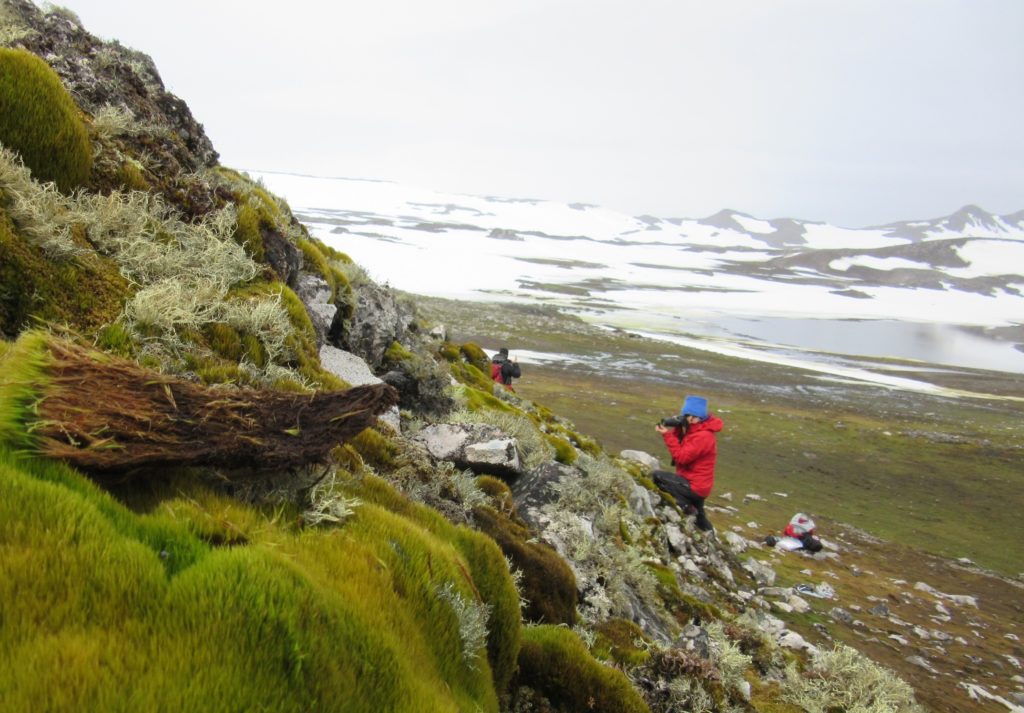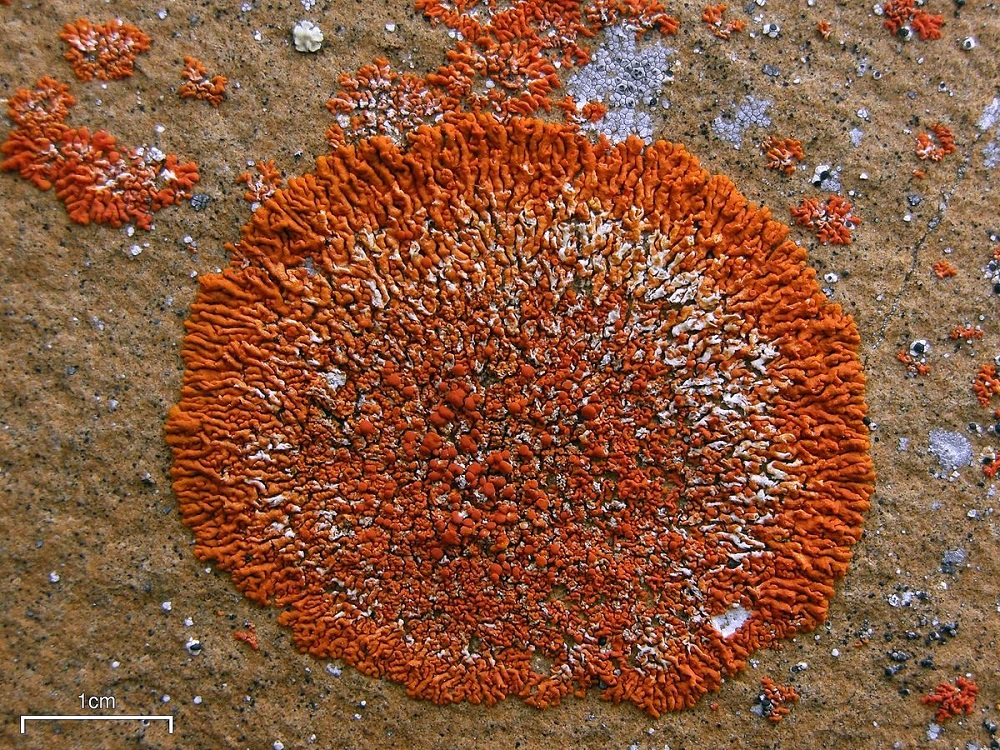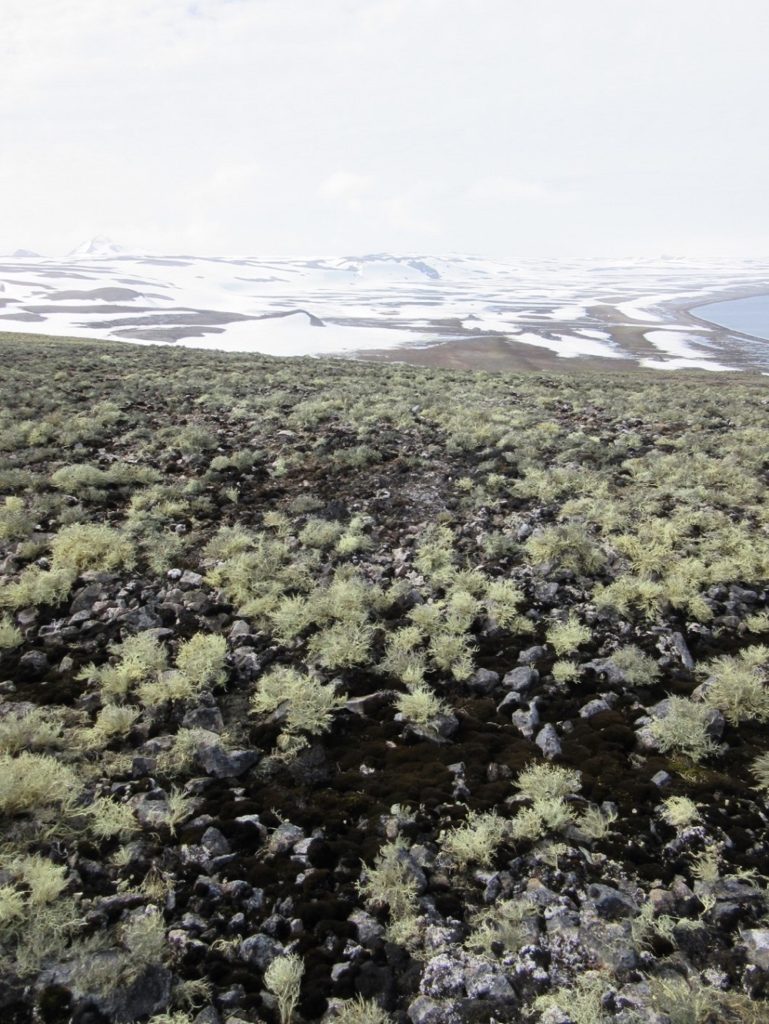The Australian Antarctic Festival is on from August 2–5th, hosted in Hobart with free tours available on our RV Investigator. We’re celebrating by exploring the hidden flora of Antarctica, in all its rugged beauty. Photo Dr Melinda Waterman
Yes: there are plants in Antarctica. No: they’re not just any old plants. No pansy or pigface (though some have flowers), the plants of Antarctica are survivors. They persist on a continent of extremes: a scarcity at one end—lack of water, heat, and nutrients—and an overabundance at the other—fierce winds and mutagenic radiation. It’s not just flowering plants that have made it to the chilliest of continents, but also mosses, and algae wrapped up in fungi to form lichens, and we’re about to tell you about them all.
Moss life
Nipped at by extreme weather conditions, Antarctic moss grows incredibly slowly. Researchers in Antarctica use radio carbon dating to determine the growth rate of plants like this moss core, showing such mosses to grow between one and six millimetres each year. Slow-growing, huh? Photo Dr Melinda Waterman
To understand mosses, plants usually reliant on conditions nearly absent in Antarctica, but surviving nonetheless, it helps to learn about their ancient, pioneering origins at a time—it’s hard to imagine—when the Earth was without plants.
There was water of course, with oceans that crashed and ponds that steamed in the sun, but as for the land? Quite bare. Life just hadn’t made it there yet. The waters teemed with it, life of ever-evolving complexity: hard-shelled creatures that pinched, and worms that swam with muscular segments, but even the plants, tangles of algae with primitive ‘leaves’ were bound to a watery home.
For these flaccid, floating plants, water was the very medium of existence: a supportive fluid that kept their bodies in shape, a source of energy and nutrients, and a reproductive conduit—the fluid through which their sperm swam to fertilise eggs.
You can imagine then, “one small mutation for a plant, one giant leap for plant-kind”, when the first threads of algae reached from the pond of life onto the land, alien and inhospitable, to see Earth, a vacuum-borne rolling stone, gather its first moss.
Okay, it wasn’t moss per se, but a primitive, weak-vesselled and rootless plant that leaned heavily on a proximity to water for nutrients, structural support, and fertilisation, but it had made it, and modern day moss is descended from this first plant. With this incredible origin story under our shared belts, let’s chat about Antarctica and how mosses have colonised another inconceivably inhospitable land.
Don’t you just want to go rolling on this dimpled, green playground of moss? Alas, the photo doesn’t convey the crisp, sub-zero air. Photo Dr Melinda Waterman
Have you heard that ‘Antarctica is the driest continent on Earth’? You’ll be pleased to know that that’s true. Further, Antarctica is not only a desert with less rainfall than the Sahara, it’s also the windiest place on Earth. Since moss can only grow where there is water—where rain falls, where dew collects, where humidity is high and air-flow low—the plants have to eke out a living on Antarctica’s coastline, where there’s fog. And in summer, when the sun’s out, another source of moisture presents itself, the melt-water that trickles down from snowbanks to dampen the rocky ‘soils’ where moss can grip.
Moss depends on water not just for nutrients, but as a medium for its sexually reproductive phase, for moss sperm (yep) to whirl through to eggs. So, how does moss have sex on this glaring, parched and iced-over desert? It doesn’t. Antarctica is so cold that moss eggs and sperm don’t form, a glacial sterilisation that forces the plants to reproduce asexually through cloning. Researchers aren’t sure whether native Antarctic mosses have totally lost the ability to have sex, or if they might regain it in more hospitable conditions. (We already know how the penguins cope, but cloning would explain why they all look the same.)
As mentioned, Antarctica is home to ferocious winds that whisk away not just humidity but precious soil, the bed for plant subsistence and the food for their growth. Just like that, the best things—food, sex, bed—have been spirited away by Antarctic winds. One vital function of soil is to provide the element nitrogen. Forming a key component of both DNA and proteins, it’s safe to call nitrogen a necessity. Given the scant soil, you might be able to guess the reason for the following observations: Antarctic moss grows on the rocks where colonies of penguins once stood, or, in green carpets downwind from the squeaking, creaking tumult of active penguin rookeries. Antarctica: the continent that gives with one nourishing, faecal wind and takes away with the other.
Given the severity of plunging Antarctic temperatures, multiple times colder than living inside your own freezer, it’s no surprise that refuge is highly sought after. It’s so sought after that moss, having found the most threadbare niche and settled down, is, itself, colonised by micro-animals like Antarctic moss piglets, tardigrades, whose rotund bodies waddle through the leafy undergrowth beneath stalk canopies, their transparent bellies glowing green from their last meal of moss—the very habitat they live in.
Lichen life
The elegant sunburst lichen (Xanthoria elegans) is one Antarctic species, and not only does the fungi-algae partnership produce habitat and sugars, but if you notice the striking flares of orange (and how can you not?), you’re looking at carotenoids, another class of compounds, which act as sun protection for the lichen, protecting against the DNA-kinking effects of UV radiation. Adaptations to extreme sun exposure are also observed in mosses, demonstrating the intense selection imposed by life in the Antarctic, and the similar mechanisms evolved to overcome it. Photo Jason Hollinger
Lichens are bizarre, composite life forms made up of fungi and either algae or cyanobacteria that might best be considered as a ‘relationship’ rather than separate organisms. Like Japanese snow monkeys, primates who’d die in their frozen habitat if not for the thick fur jackets of their family troop, lichens are able to survive in Antarctica through ’emergent properties’ imparted by their symbiotic relationship.
Algae are an important component of lichens; they are the same species that grow independently on tree bark and rocks. With the help of their host fungi, these otherwise free-living terrestrial or aquatic plants are able to pioneer a new habitat in their encrusting, lichen ‘fish bowl’ residences, enabling the ‘algae out of water’ to continue photosynthesising. Not only do fungi provide a terrestrial home, they also absorb water and nutrients in that air supporting the growth of both.
And while the fungus act as the room, the alga acts as the tenant, paying rent by way of sugars produced through photosynthesis. It’s these sugars that enable the fungi to survive on a substrate that’s otherwise without nutrients: rock bottom, or pebble bottom, the main ways to live in Antarctica.
We said life’s rough in Antarctica and that’s no less true with the substrate—check out these hardy ‘shrubs’ of Usnea lichen making a fragile, coral-like garden among the coarse ‘gravel soil’. Photo Dr Melinda Waterman
By the way, if you ever think you’re not going anywhere fast, just liken your trials to Antarctic lichen: a three-legged race in which an entire millennium can pass you by without growing a centimetre.
Flower life
Flowers, like the colours of leaves and the songs of birds, are symbols of the shifting seasons and things are no different in Antarctica even though they’re mostly stuck *excuse the vulgarity* ‘where the sun don’t shine’.
Typically, frost is enough to kill plants—the water inside them freezing into arrays of glassy crystals that puncture cells and tear tissue—but not the two species of flowering plants in Antarctica: Deschampsia antarctica (a grass) and an as yet unnamed species of Colobanthus (a member of a family that also contains carnations!)
A tuft of Deschampsia antarctica, also known as Antarctic Hair-grass and one of the only vascular plants present on the continent. The leaf blades of D. antarctica are thick-skinned, and hardy for life in the cold. Photo Dr Melinda Waterman
Though they’re mostly confined to warmer islands and coastlines, these flowering plants are able to endure the frost, lying dormant in patient mats under masses of ice and snow for most of the year, ‘waking up’ at the arrival of the sun and the melting of snow for the brief Antarctic summer. Really, though, they’ve got no choice.
If you imagine it, the window available for seeds to germinate is small—just three months, only as long as the summer keeps the snow melted and ground exposed. Both these Antarctic species have fast-germinating seeds, allowing seedlings to grow enough to establish themselves before the next deluge of frost. Then, they lie; and they wait.
The future of Antarctic flora
Heard Island. Photo Matt Curnock
Antarctica is changing. Quickly. Scientists are alarmed at this rate of change and the effects that are cascading faster than can be measured. Summers are warmer and staying warmer for longer, exposing more ground to exotic colonists like Kentucky Bluegrass, which has not only arrived in Antarctica recently, but has established itself on the coastline, laying down a turf war and competing with the two native flowering plant species.
And, in spring—the eye of the ozone hole, like the roving lens of a magnifying glass passes over, blazing UV radiation onto the native inhabitants. Like our sensitive human skin, dependent on sunshine but very quickly blushed then seared by it, plants, too, must balance their sun exposure. With no trees and canopy cover, plants are vulnerable to this harsh radiation, and their naturally evolved sunscreens might not be adequate to protect from the sudden increase in UV.
Wherever we step, our human footprint imprints a rag-tag collection of ‘cosmopolitan species’ that are all too familiar—rabbits, rats, pigeons…bluegrass—you know the drill, draining Earth’s rich biodiversity into a monotone like a drab day, and it’s these footprints (sometimes literally, as in the introduction of bluegrass seeds on the soles of shoes) that Antarctic researchers are working hard to manage—ensuring the environment, white and pristine, and the flora, the gardens in the ice, remain intact.
If you can’t make it to the Antarctic Festival in Hobart (2nd–5th August 2018), our National Research Collections Australia has a joint herbarium—a repository for specimens collected from Antarctica, including mosses, lichens, and more.









10th August 2018 at 9:57 pm
Great article, more reasons NOT to be a tourist, let our experiences be mediated by experts to protect what remains
4th August 2018 at 6:07 pm
I’m with Ron Knight. Any delight and amazement on the versatility of introduced species collapses when they proceed to invade and displace native species and habitats that are even more amazing and worthy of study. Victor should join a bushcare group and enjoy the opportunity to wonder at the invasive versatility of eryharta, erogrostis, bidens, blackberry, whiskey grass, asthma weed, cassia, privet, emex……(ad nauseum). and their displacement of native flora, whether delicate or tough, and its dependant fauna that once thrived in our creeks, rivers, wetlands, mountains, plains…. Biodiversity is vanishing faster than science can record it.
28th July 2018 at 6:04 pm
Fascinating article.
I am amazed that the blue grass seed was transported there on the boots of researchers
Was/is there no checks on footwear?
That seems to me to be a terrible over sight.
As you say us humans take our footprints wherever we go,mostly to me at least
detrimentally to the good of those places
I dread humans setting foot on other planets and the wrecking ball
effect they will have on those planets.
Best they stay at home in my opinion.
27th July 2018 at 3:24 pm
Wonderful to see just how successful life has adapted and flourished in such harsh environments !!